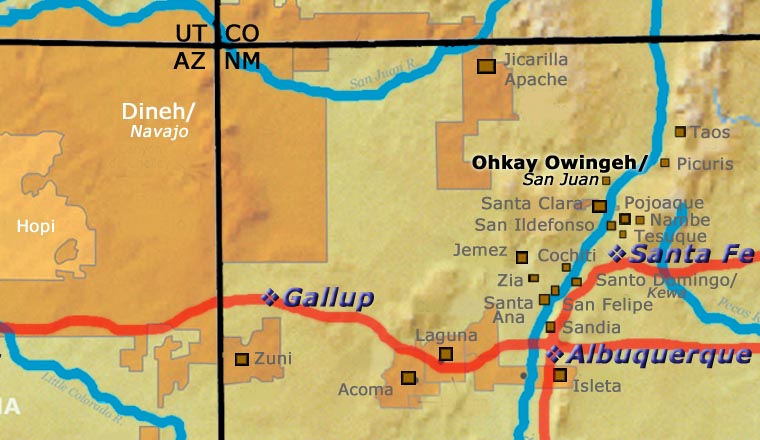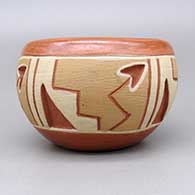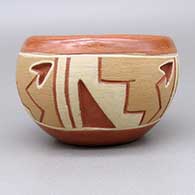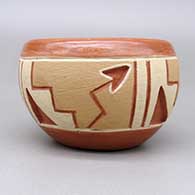
Dominguita Sisneros
Ohkay Owingeh(San Juan)
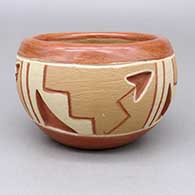
Dominguita Sisneros was born into Ohkay Owingeh in May 1942. Her father was Juan Sisneros of Santa Clara. Her mother was Tomasita Reyes Montoya, one of the seven Ohkay Owingeh women who innovated the modern incised style of Ohkay Owingeh pottery known as Potsuwi'i.
Dominguita and her sister, Rosita de Herrera, learned to make pottery as they grew up, watching and working with their mother as she made pottery. Dominguita became an active potter around 1955 but she still collaborated with her mother often until her mother passed on in 1978.
Dominguita was a participant in the Santa Fe Indian Market, Heard Museum Guild Indian Arts Fair & Market, the New Mexico State Fair and the Eight Northern Pueblos Arts & Crafts Show for years and earned multiple ribbons. Some of her work can be seen at the Heard Museum, the Millicent Rogers Museum, the Palace of the Governors Museum, the Museum of New Mexico and the Pueblo Indian Cultural Center.
Dominguita taught her daughters, Jennifer Sisneros [Tse Pe][Naranjo] and Jeanette Teba, to make pottery. Jennifer became the second wife of Tse Pe (of San Ildefonso) and signed her pieces as Jennifer Tse Pe for a while. When he passed on, she moved to Santa Clara and reassumed her maiden name, until she married Alfred Naranjo.
Dominguita signed her pieces using several different names. Among them were: Dominguita Reyes Montoya, Dominguita Sisneros, Dominguita Sandy Naranjo, Dominguita Sisneros Naranjo, Dominguita Sandy Sisneros and Dominguita Cisneros.
100 West San Francisco Street, Santa Fe, New Mexico 87501
(505) 986-1234 - www.andreafisherpottery.com - All Rights Reserved

Ohkay Owingeh (San Juan)
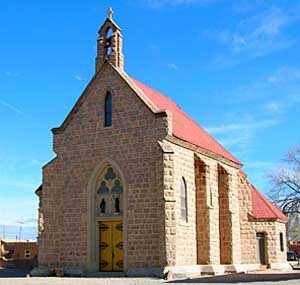
Ohkay Owingeh Mission
In 2005 San Juan Pueblo officially changed its name back to the original name (before the Spanish arrived): Ohkay Owingeh (meaning: Place of the strong people). The pueblo was founded around 1200 AD during the time of the great Southwest drought and migrations. The people speak Tewa and may have come to the Rio Grande area from southwestern Colorado or from the San Luis Valley in central Colorado.
Spanish conquistador Don Juan de Oñate took control of the pueblo in 1598, renaming it San Juan de los Caballeros (after his patron saint, John the Baptist). He established the first Spanish capitol of Nuevo Mexico across the Rio Grande in an area he named San Gabriel. In 1608, the capitol was moved south to an uninhabited area that became the Santa Fe we know today.
After 80 years of progressively deteriorating living conditions under the Spanish, the tribe participated in the Pueblo Revolt of 1680 (one of the revolt's ringleaders, Popé, was an Ohkay Owingeh native) and helped to expel the Spanish from Nuevo Mexico for 12 years. However, when the Spanish returned in 1692 that tribal unity had fallen apart and the individual pueblos were relatively easy for the Spanish to reconquer.
Today, Ohkay Owingeh is the largest Tewa-speaking pueblo (in population and land) but few of the younger generations are interested in carrying on with many of the tribe's traditional arts and crafts (such as the making of pottery). The pueblo is home to the Eight Northern Indian Pueblos Council, the Oke-Oweenge Arts Cooperative, the San Juan Lakes Recreation Area and the Ohkay Casino & Resort. The tribe's Tsay Corporation is one of northern New Mexico's largest private employers.
100 West San Francisco Street, Santa Fe, New Mexico 87501
(505) 986-1234 - www.andreafisherpottery.com - All Rights Reserved

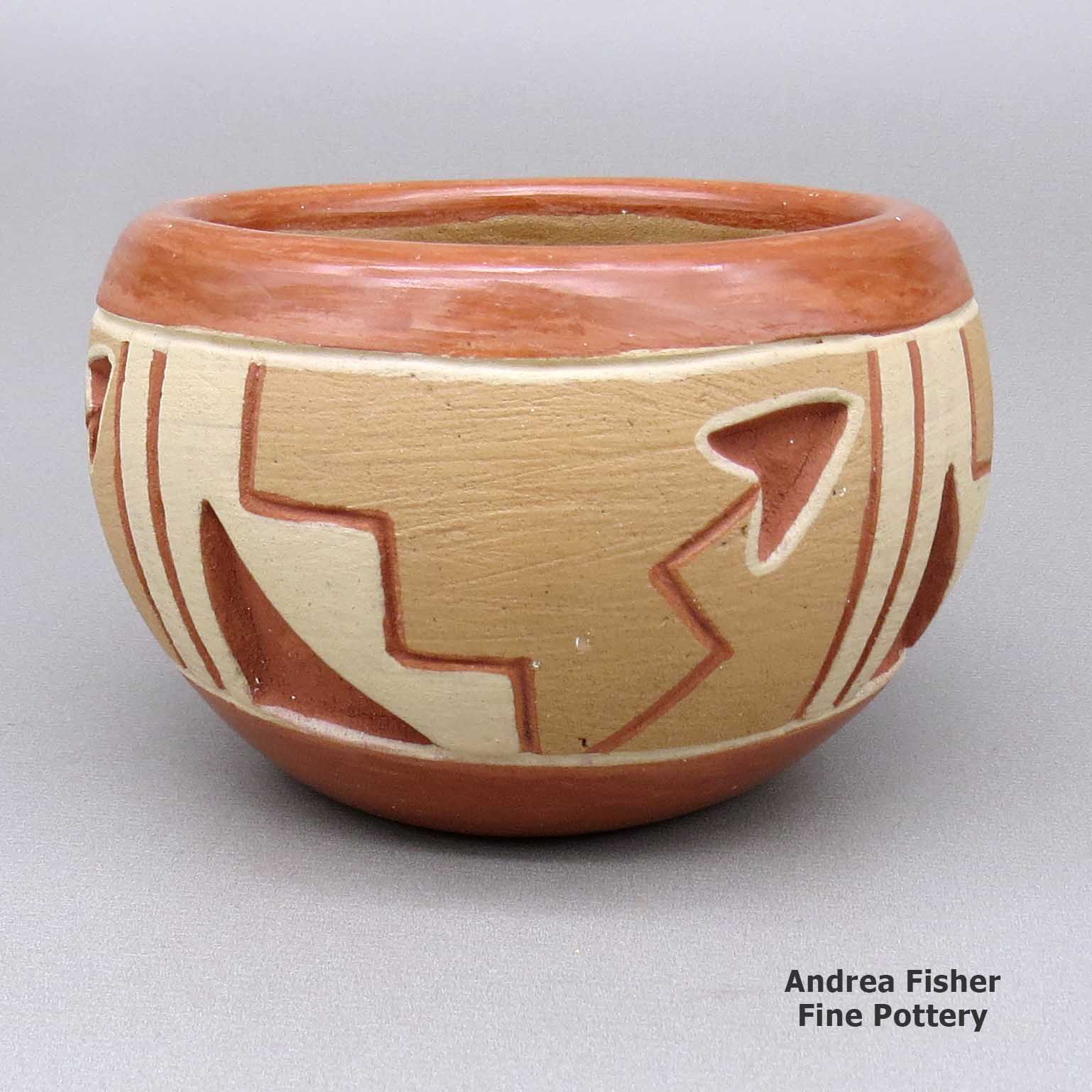
Dominguita Sisneros, Ohkay_Owingeh, PolychromePotsuwiibowlwithacarvedandpaintedfour-panelkivastep,lightningbolt,andgeometricdesign
Ohkay Owingeh
$ 275
thsj3k277
Polychrome Potsuwii bowl with a carved and painted four-panel kiva step, lightning bolt, and geometric design
4.25 in L by 4.25 in W by 2.75 in H
Condition: Very good, has pitting and normal wear
Signature: Dominguita Sisneros
100 West San Francisco Street, Santa Fe, New Mexico 87501
(505) 986-1234 - www.andreafisherpottery.com - All Rights Reserved

Tomasita Reyes Montoya Family Tree
Disclaimer: This "family tree" is a best effort on our part to determine who the potters are in this family and arrange them in a generational order. The general information available is questionable so we have tried to show each of these diagrams to living members of each family to get their input and approval, too. This diagram is subject to change should we get better info.
- Tomasita Reyes Montoya (1899-1978) and Juan Reyes Montoya
- Dominguita Naranjo (Sisneros)(1942-) and Juan Sisneros
- Jennifer Sisneros and Alfred E. Naranjo (Santa Clara)
- Alfred J. Naranjo
- Jeannette Teba and Steven Teba Sr.
- Steven Teba Jr.
- Veronica Teba
- Jennifer Sisneros and Alfred E. Naranjo (Santa Clara)
- Rosita de Herrera
- Norman de Herrera
Some of the above info is drawn from Pueblo Indian Pottery, 750 Artist Biographies, by Gregory Schaaf, © 2000, Center for Indigenous Arts & Studies
Other info is derived from personal contacts with family members and through interminable searches of the Internet.
(505) 986-1234 - www.andreafisherpottery.com - All Rights Reserved
